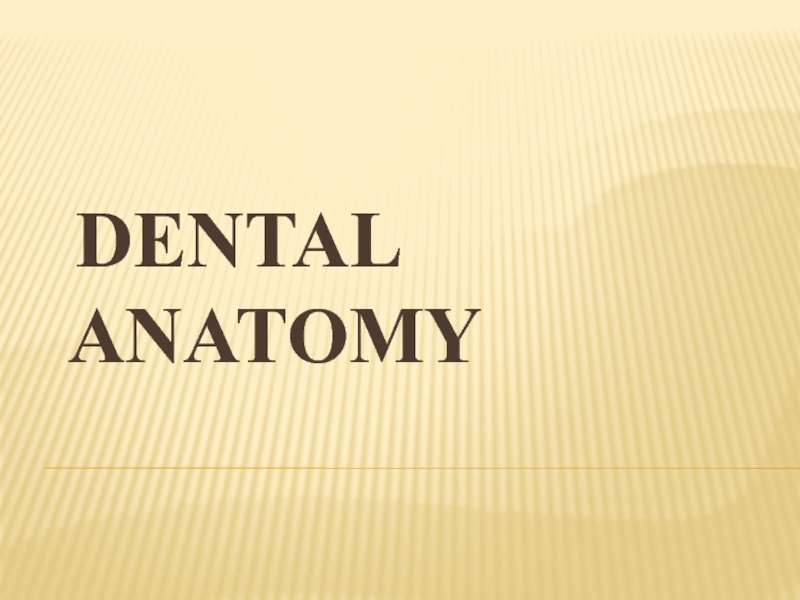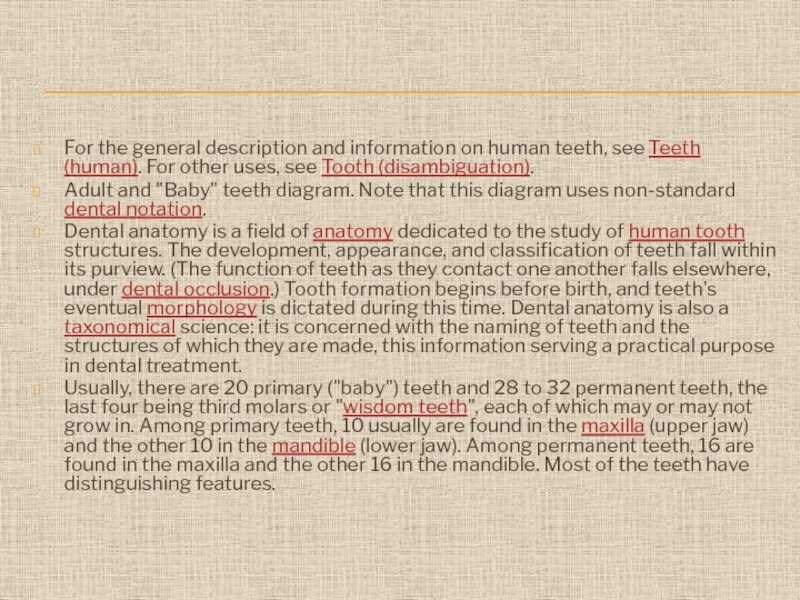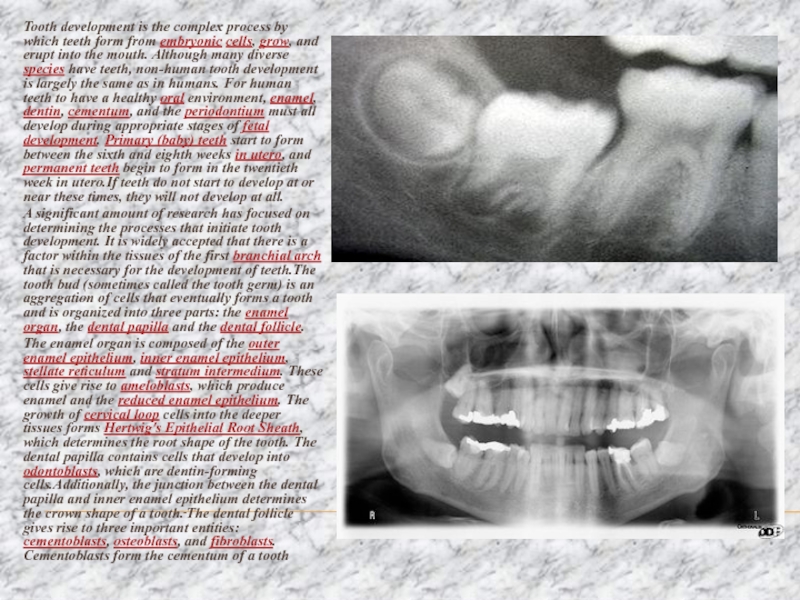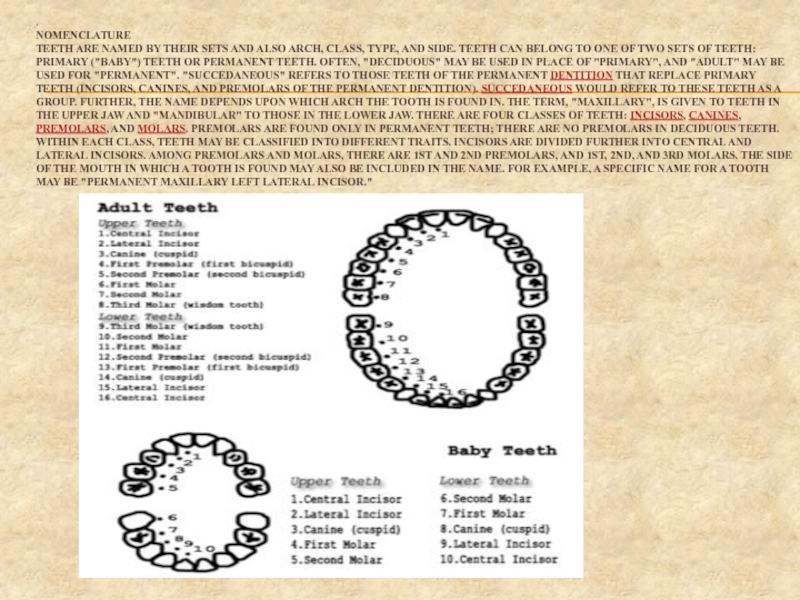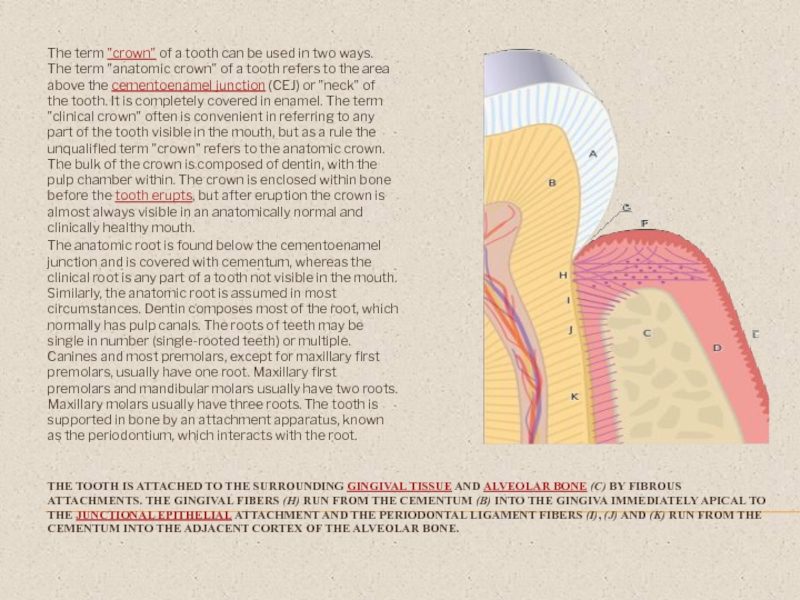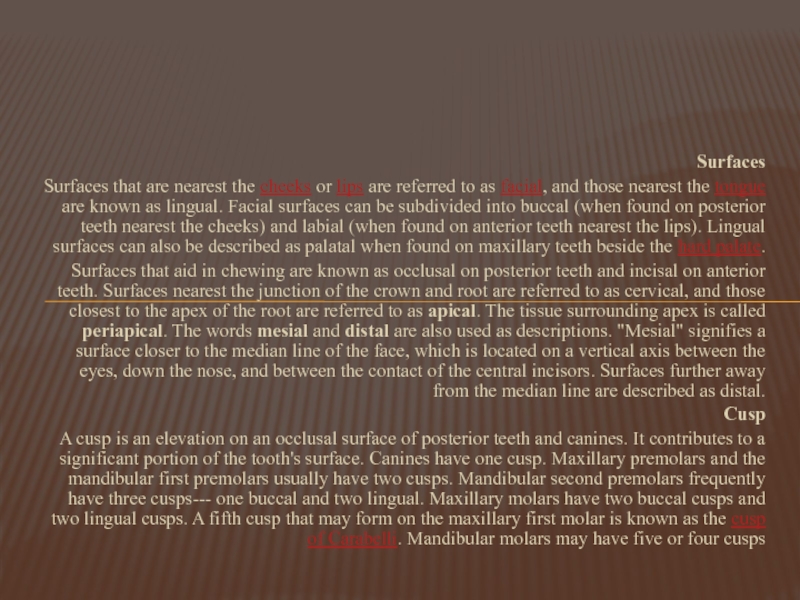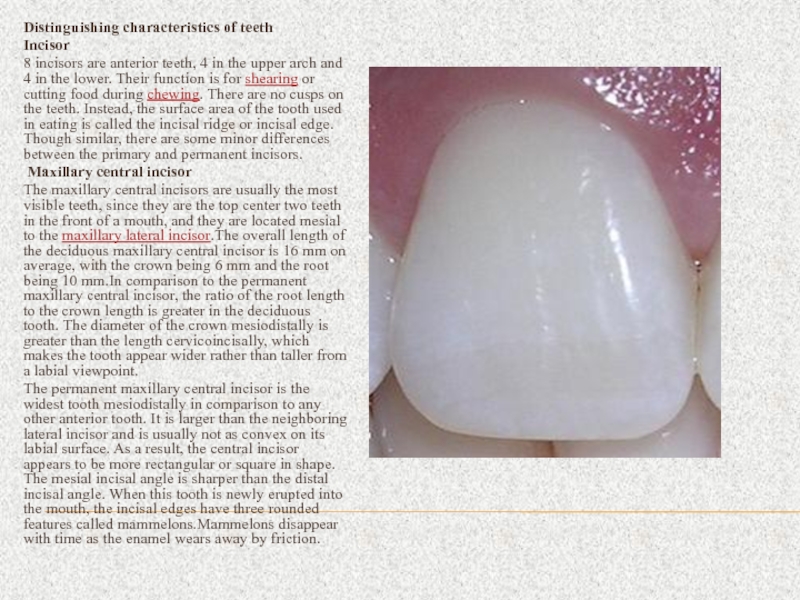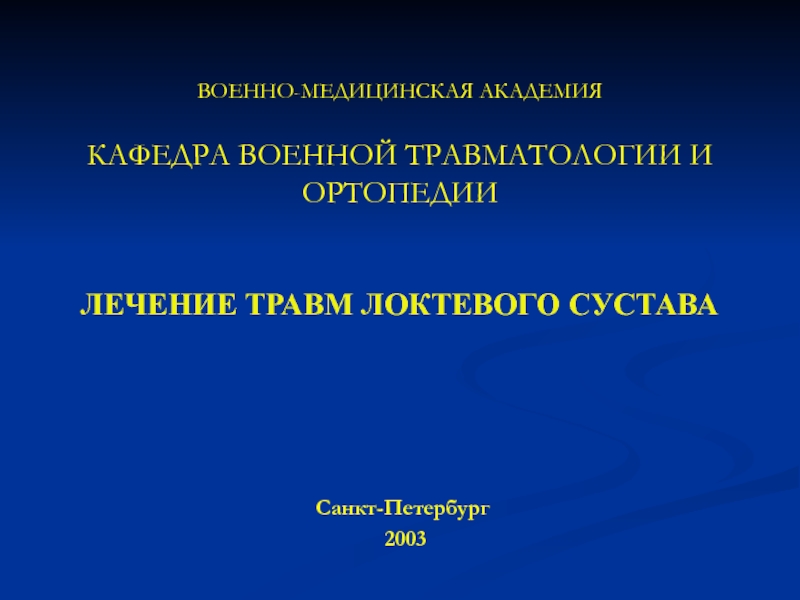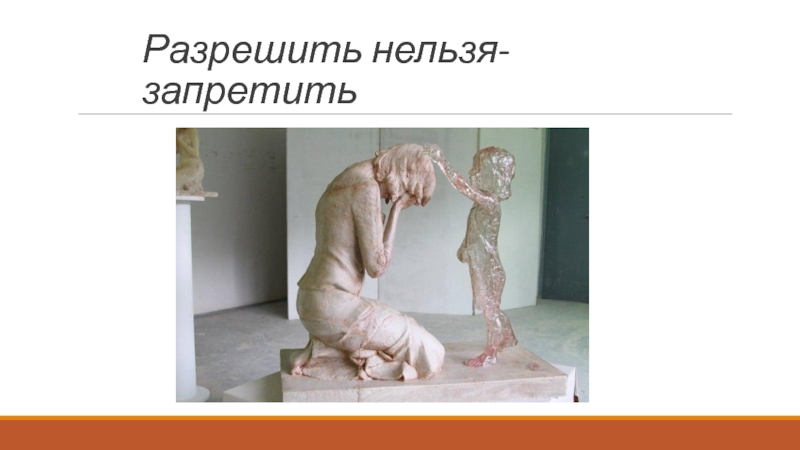- Главная
- Разное
- Дизайн
- Бизнес и предпринимательство
- Аналитика
- Образование
- Развлечения
- Красота и здоровье
- Финансы
- Государство
- Путешествия
- Спорт
- Недвижимость
- Армия
- Графика
- Культурология
- Еда и кулинария
- Лингвистика
- Английский язык
- Астрономия
- Алгебра
- Биология
- География
- Детские презентации
- Информатика
- История
- Литература
- Маркетинг
- Математика
- Медицина
- Менеджмент
- Музыка
- МХК
- Немецкий язык
- ОБЖ
- Обществознание
- Окружающий мир
- Педагогика
- Русский язык
- Технология
- Физика
- Философия
- Химия
- Шаблоны, картинки для презентаций
- Экология
- Экономика
- Юриспруденция
Dental anatomy презентация
Содержание
- 1. Dental anatomy
- 2. For the general description and information on
- 3. Tooth development is the complex process by
- 4. . NOMENCLATURE TEETH ARE NAMED BY THEIR
- 5. THE TOOTH IS ATTACHED TO THE SURROUNDING
- 6. Surfaces Surfaces that are nearest the cheeks
- 7. Distinguishing characteristics of teeth Incisor 8 incisors
Слайд 2For the general description and information on human teeth, see Teeth
Adult and "Baby" teeth diagram. Note that this diagram uses non-standard dental notation.
Dental anatomy is a field of anatomy dedicated to the study of human tooth structures. The development, appearance, and classification of teeth fall within its purview. (The function of teeth as they contact one another falls elsewhere, under dental occlusion.) Tooth formation begins before birth, and teeth's eventual morphology is dictated during this time. Dental anatomy is also a taxonomical science: it is concerned with the naming of teeth and the structures of which they are made, this information serving a practical purpose in dental treatment.
Usually, there are 20 primary ("baby") teeth and 28 to 32 permanent teeth, the last four being third molars or "wisdom teeth", each of which may or may not grow in. Among primary teeth, 10 usually are found in the maxilla (upper jaw) and the other 10 in the mandible (lower jaw). Among permanent teeth, 16 are found in the maxilla and the other 16 in the mandible. Most of the teeth have distinguishing features.
Слайд 3Tooth development is the complex process by which teeth form from
A significant amount of research has focused on determining the processes that initiate tooth development. It is widely accepted that there is a factor within the tissues of the first branchial arch that is necessary for the development of teeth.The tooth bud (sometimes called the tooth germ) is an aggregation of cells that eventually forms a tooth and is organized into three parts: the enamel organ, the dental papilla and the dental follicle.
The enamel organ is composed of the outer enamel epithelium, inner enamel epithelium, stellate reticulum and stratum intermedium. These cells give rise to ameloblasts, which produce enamel and the reduced enamel epithelium. The growth of cervical loop cells into the deeper tissues forms Hertwig's Epithelial Root Sheath, which determines the root shape of the tooth. The dental papilla contains cells that develop into odontoblasts, which are dentin-forming cells.Additionally, the junction between the dental papilla and inner enamel epithelium determines the crown shape of a tooth. The dental follicle gives rise to three important entities: cementoblasts, osteoblasts, and fibroblasts. Cementoblasts form the cementum of a tooth
Слайд 4. NOMENCLATURE TEETH ARE NAMED BY THEIR SETS AND ALSO ARCH, CLASS, TYPE,
Слайд 5THE TOOTH IS ATTACHED TO THE SURROUNDING GINGIVAL TISSUE AND ALVEOLAR
The term "crown" of a tooth can be used in two ways. The term "anatomic crown" of a tooth refers to the area above the cementoenamel junction (CEJ) or "neck" of the tooth. It is completely covered in enamel. The term "clinical crown" often is convenient in referring to any part of the tooth visible in the mouth, but as a rule the unqualified term "crown" refers to the anatomic crown. The bulk of the crown is composed of dentin, with the pulp chamber within. The crown is enclosed within bone before the tooth erupts, but after eruption the crown is almost always visible in an anatomically normal and clinically healthy mouth.
The anatomic root is found below the cementoenamel junction and is covered with cementum, whereas the clinical root is any part of a tooth not visible in the mouth. Similarly, the anatomic root is assumed in most circumstances. Dentin composes most of the root, which normally has pulp canals. The roots of teeth may be single in number (single-rooted teeth) or multiple. Canines and most premolars, except for maxillary first premolars, usually have one root. Maxillary first premolars and mandibular molars usually have two roots. Maxillary molars usually have three roots. The tooth is supported in bone by an attachment apparatus, known as the periodontium, which interacts with the root.
Слайд 6Surfaces
Surfaces that are nearest the cheeks or lips are referred to
Surfaces that aid in chewing are known as occlusal on posterior teeth and incisal on anterior teeth. Surfaces nearest the junction of the crown and root are referred to as cervical, and those closest to the apex of the root are referred to as apical. The tissue surrounding apex is called periapical. The words mesial and distal are also used as descriptions. "Mesial" signifies a surface closer to the median line of the face, which is located on a vertical axis between the eyes, down the nose, and between the contact of the central incisors. Surfaces further away from the median line are described as distal.
Cusp
A cusp is an elevation on an occlusal surface of posterior teeth and canines. It contributes to a significant portion of the tooth's surface. Canines have one cusp. Maxillary premolars and the mandibular first premolars usually have two cusps. Mandibular second premolars frequently have three cusps--- one buccal and two lingual. Maxillary molars have two buccal cusps and two lingual cusps. A fifth cusp that may form on the maxillary first molar is known as the cusp of Carabelli. Mandibular molars may have five or four cusps
Слайд 7Distinguishing characteristics of teeth
Incisor
8 incisors are anterior teeth, 4 in the
Maxillary central incisor
The maxillary central incisors are usually the most visible teeth, since they are the top center two teeth in the front of a mouth, and they are located mesial to the maxillary lateral incisor.The overall length of the deciduous maxillary central incisor is 16 mm on average, with the crown being 6 mm and the root being 10 mm.In comparison to the permanent maxillary central incisor, the ratio of the root length to the crown length is greater in the deciduous tooth. The diameter of the crown mesiodistally is greater than the length cervicoincisally, which makes the tooth appear wider rather than taller from a labial viewpoint.
The permanent maxillary central incisor is the widest tooth mesiodistally in comparison to any other anterior tooth. It is larger than the neighboring lateral incisor and is usually not as convex on its labial surface. As a result, the central incisor appears to be more rectangular or square in shape. The mesial incisal angle is sharper than the distal incisal angle. When this tooth is newly erupted into the mouth, the incisal edges have three rounded features called mammelons.Mammelons disappear with time as the enamel wears away by friction.
